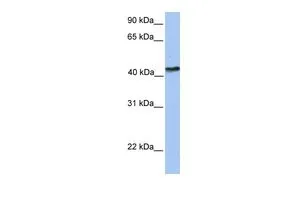anti-IGFLR1 (human), pAb (IN101)
AG-25B-0026
ApplicationsFlow Cytometry, Western Blot
Product group Antibodies
ReactivityHuman
TargetIGFLR1
Overview
- SupplierAdipoGen Life Sciences
- Product Nameanti-IGFLR1 (human), pAb (IN101)
- Delivery Days Customer10
- ApplicationsFlow Cytometry, Western Blot
- CertificationResearch Use Only
- ClonalityPolyclonal
- Concentration1 mg/ml
- Gene ID79713
- Target nameIGFLR1
- Target descriptionIGF like family receptor 1
- Target synonymsTMEM149, IGF-like family receptor 1, transmembrane protein 149
- HostRabbit
- Protein IDQ9H665
- Protein NameIGF-like family receptor 1
- Scientific DescriptionInsulin-growth factor-like gene family is a new family of proteins consisting of four proteins in humans (IGFL1 to 4) and one in mice (mIGFL). mIGFL is expressed in normal skin in mice and further upregulated during inflammation responses in skin or after skin wounding. In human only IGFL1 expression is increased in psoriatic skin samples. Mouse IGFL and human IGFL1 and 3 interact with specificity and high affinity to a novel receptor named IGF-like family receptor 1 (formerly TMEM-149). Analysis of the amino acid sequence of IGFLR1 indicated that this receptor is likely a novel member of the TNFR family. IGFLR1 is expressed most abundantly on mouse T cells, suggesting that mIGFL and IGFL1 produced in the skin may potentially exert regulatory functions on T cell responses. - Polyclonal Antibody. Recognizes human IGFLR1. Does not recognize mouse IGFLR1. Source: Rabbit. Applications: FACS, WB. Liquid. In PBS containing 10% glycerol and 0.02% sodium azide. Insulin-growth factor-like gene family is a new family of proteins consisting of four proteins in humans (IGFL1 to 4) and one in mice (mIGFL). mIGFL is expressed in normal skin in mice and further upregulated during inflammation responses in skin or after skin wounding. In human only IGFL1 expression is increased in psoriatic skin samples. Mouse IGFL and human IGFL1 and 3 interact with specificity and high affinity to a novel receptor named IGF-like family receptor 1 (formerly TMEM-149). Analysis of the amino acid sequence of IGFLR1 indicated that this receptor is likely a novel member of the TNFR family. IGFLR1 is expressed most abundantly on mouse T cells, suggesting that mIGFL and IGFL1 produced in the skin may potentially exert regulatory functions on T cell responses.
- ReactivityHuman
- Storage Instruction-20°C,2°C to 8°C
- UNSPSC12352203




